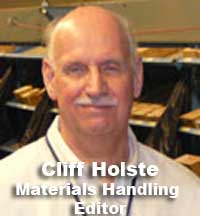From SCDigest's On-Target E-Magazine
- Aug. 7, 2013 -
Logistics News: Material Handling Automation Projects - By the Book
Detailed Documentation of a Project from Beginning to End Provides Central Record for All Stakeholders - but is Not Commonly Used
SCDigest Editorial Staff
There are about as many styles of project management for material handling automation as there are consultants, but SCDigest Materials Handling Editor Cliff Holste believes there is one tool that should be common across all of them - development of a "Materials Handling Planning Book."
This is a technique Holste himself has used for many years and involves the creation of a single "binder" that is developed and maintained for all key stakeholders in the project. It becomes the book of record for the project, and thus documents a wide variety of information, from goals and objectives to - critically - all the decisions that are made and why they were made.
"Even after the contract is signed and you think all the details of the system are defined, there are literally dozens of decisions that will still need to be made throughout the life of the project," Holste says. "Far too often, those decisions are not formally documented, or are documented in emails or some other more informal fashion - and that can cause problems later."
 It might be weeks or months into the project, and someone questions why a given decision was made - for example, why a specific type of sortation equipment was selected, or specifics of how the interface between the Warehouse Management Systems and Warehouse Control System interface will work - and no one can precisely remember what the details were of that decision, or sometimes even who made it. A Project manager at the company may have made a decision, and senior executives not even be aware that the decision was made. It might be weeks or months into the project, and someone questions why a given decision was made - for example, why a specific type of sortation equipment was selected, or specifics of how the interface between the Warehouse Management Systems and Warehouse Control System interface will work - and no one can precisely remember what the details were of that decision, or sometimes even who made it. A Project manager at the company may have made a decision, and senior executives not even be aware that the decision was made.
"Most of the decisions have cost or operational impacts, sometimes significant ones," Holste says. "Organized, detailed documentation is essential to understand how the project is where it is at any given point in the cycle, and most importantly needed to reduce potential conflict between companies, consultants and system vendors over why and by whom decisions were made."
The Planning Book might be updated weekly, with the additions sent to all the stakeholders that have the book. Once the project is in full swing, those updates often come in the form of detailed minutes of any meetings during the past week. Holste says his technique was to first send out the week's documents electronically for any changes or additions, and then bring the physical documents with any of the changes to the next team meeting.
But the book contains a lot more data than just a record of decisions. Holste has used the following general structure for each planning book, though of course there could be variations to this basic format. It represents the structure that might be used say for design and development of a carton sortation system in distribution.
Example Materials Handling System Planning Book Structure
Section |
Table of Contents |
Description |
1 |
Glossary of Terms |
There are standard industry related terms and specific user terms. In order to avoid confusion all applicable project related terms will be listed and described. |
2 |
Project Goals |
Specific operational and productivity goals will be developed and described. These will become the yardstick for measuring project success. |
3 |
Assumption & Constraints |
Assumptions and constraints will be developed and documented so that they can become a part of the design criteria. |
4 |
Decisions |
This is a list of items that are considered to be absolute and not subject to change. |
5 |
WMS & WCS |
The keys to successful deployment of these critical software and control systems lie in the development of comprehensive functionality statements. |
6 |
Data Analysis |
Item Master, SKU Velocity Reports, On-Hand Inventory Records, Sales Forecasts, etc., will be utilized to develop system operational and flow requirements. |
7 |
Design & Performance Criteria |
This is a list of items that are used to drive the system design. |
8 |
Concept Drawings |
In the Initialization Phase dimensionally accurate, 11" x 17" layouts of the facility and system arrangement will be developed in color utilizing Microsoft Visio. |
9 |
Description of Operation |
Once the system concept has been developed, an operations plan will be written so the key operational requirements can be identified and described. |
10 |
Planning Report |
This is a high level assessment of current warehousing and distribution operations and improvement recommendations. |
11 |
Pricing & Justification |
Collaborative pricing formulary and budget pricing. |
12 |
Meeting Minutes Record |
Contains minutes of all project team meetings. |
Source: Cliff Holste
A surprising number of projects do not have this level of documentation, leading to misunderstandings and sometimes major conflicts.
(Distribution/Materials Handling Story Continues Below
)
|